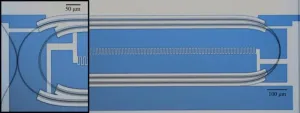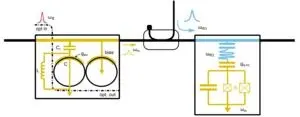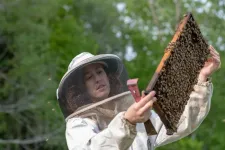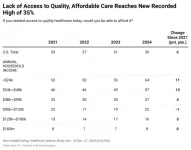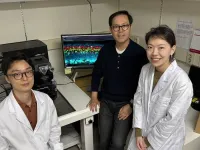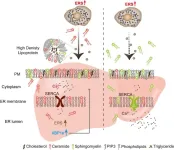(Press-News.org) Applied physicists at the Harvard John A. Paulson School of Engineering and Applied Sciences (SEAS) have created a photon router that could plug into quantum networks to create robust optical interfaces for noise-sensitive microwave quantum computers.
The breakthrough is a crucial step toward someday realizing modular, distributed quantum computing networks that leverage existing telecommunications infrastructure. Comprising millions of miles of optical fiber, today’s fiber-optic networks send information between computing clusters as pulses of light, or photons, all around the world in the blink of an eye.
Led by Marko Lončar, the Tiantsai Lin Professor of Electrical Engineering and Applied Physics at SEAS, the team has created a microwave-optical quantum transducer, a device designed for quantum processing systems that use superconducting microwave qubits as their smallest units of operation (analogous to the 1s and 0s of classical bits). The research is published in Nature Physics.
Effectively a router for photons, the transducer bridges the large energy gap between microwave and optical photons, thus enabling control of microwave qubits with optical signals generated many miles away. The device is the first of its kind to demonstrate control of a superconducting qubit using only light.
Paper first author and graduate student Hana Warner said the transducer offers a way to tap the power of optics when dreaming up quantum networks. “The realization of these systems is still a ways out, but in order to get there, we need to figure out practical ways to scale and interface with the different components,” Warner said. “Optical photons are one of the best ways you can do that, because they’re very good carriers of information, with low loss, and high bandwidth.”
Superconducting qubits, which are nanofabricated circuits engineered for different energy states, are an emerging quantum computing platform due to their scalability, compatibility with existing manufacturing processes, and ability to maintain quantum superposition long enough to perform calculations.
But one of the major bottlenecks to deploying superconducting microwave qubit platforms is the extremely low temperatures at which they must operate, necessitating large cooling systems called dilution refrigerators. Since future quantum computing will require millions of qubits to operate, scaling these systems only on microwave-frequency signals is challenging. The solution lies in using microwave qubits to do the quantum operations, but to use optical photons as efficient and scalable interfaces.
That’s where the transducer comes in.
The Harvard team’s 2-millimeter optical device resembles a paper clip and sits on a chip that’s about 2 centimeters in length. It works by linking a microwave resonator with two optical resonators, allowing back-and-forth exchange of energy enabled by the properties of their base material, lithium niobate. The team leveraged this exchange to eliminate the need for bulky, hot microwave cables for controlling qubit states.
The same devices used for control could be used for qubit state readout, or for forming direct links to convert finicky quantum information into sturdy packets of light between quantum computing nodes. The breakthrough brings us closer to a world with superconducting quantum processors connected by low-loss, high-powered optical networks.
“The next step for our transducer could be reliable generation and distribution of entanglement between microwave qubits using light,” Lončar said.
The Harvard team combined their expertise in optical systems with collaborators at Rigetti Computing, who provided the superconducting qubit platform on which the researchers tested their transducer and mapped out different experiments. Other collaborators were from University of Chicago and Massachusetts Institute of Technology.
Fabrication of the chips was performed at Harvard’s Center for Nanoscale Systems, a member of the National Nanotechnology Coordinated Infrastructure Network, which is supported by National Science Foundation Award No. 1541959.
The work was further supported by the Air Force Research Laboratory under award RCP06360; the National Science Foundation under awards EEC-1914583, OMA-2137723, OMA-1936118, ERC-1941583, and OMA-2137642; the Defense Advanced Research Projects Agency under award HR01120C0137; the Department of Defense under award FA8702-15-D-000; the Department of Energy under award DE-SC0020376; the Air Force Office of Scientific Research under awards FA9550-20-1, FA9550-19-1-0399, and FA9550-21-1-0209; the Army Research Office under awards W911NF-20-1-0248, W911NF-23-1- 0077, and W911NF-21-1-0325; and NTT Research, Packard Foundation under award 2020-71479.
END
A router for photons
Transducer could enable superconducting quantum networks
2025-04-02
ELSE PRESS RELEASES FROM THIS DATE:
Nurses and AI collaborate to save lives, reduce hospital stays
2025-04-02
NEW YORK, NY (April 2, 2025)--
April 2, 2025—An AI tool that analyzes nurses’ data and notes detected when patients in the hospital were deteriorating nearly two days earlier than traditional methods and reduced the risk of death by over 35%, found a year-long clinical trial of more than 60,000 patients led by researchers at Columbia University.
The new AI tool, CONCERN Early Warning System, uses machine learning to analyze nursing documentation patterns to predict when a hospitalized patient is deteriorating before the change is reflected in vital signs, allowing for timely, life-saving ...
Multi-resistance in bacteria predicted by AI model
2025-04-02
An AI model trained on large amounts of genetic data can predict whether bacteria will become antibiotic-resistant. The new study shows that antibiotic resistance is more easily transmitted between genetically similar bacteria and mainly occurs in wastewater treatment plants and inside the human body.
"By understanding how resistance in bacteria arises, we can better combat its spread. This is crucial to protect public health and the healthcare system's ability to treat infections," says Erik Kristiansson, Professor at the Department of Mathematical Sciences at Chalmers University of Technology and the University of Gothenburg in Sweden.
Antibiotic ...
Tinker Tots: A citizen science project to explore ethical dilemmas in embryo selection
2025-04-02
EMBARGOED UNTIL 09:00 BST WEDNESDAY 2 APRIL
Tinker Tots: A Citizen Science Project to Explore Ethical Dilemmas in Embryo Selection
Researchers at the University of Oxford, University of Exeter, and the National University of Singapore Yong Loo Lin School of Medicine present a new, interactive study.
Oxford, 2 April 2025: When choosing an embryo for implantation during in vitro fertilization (IVF), would you consider its chances of developing a health condition? What about traits like creativity, intelligence, ...
Sensing sickness
2025-04-02
Beekeepers in the United States lost more than 55 percent of managed colonies last year—the highest loss rate since the Apiary Inspectors of America began determining them in 2011. A new study from University of Vermont scientists and international collaborators supports a novel method for testing hygienic behavior in honey bees that could promote breeding more disease resistant colonies in the future.
“Beekeepers are losing bees at a rate that they say is unsustainable,” says Samantha Alger, director of the Vermont Bee Lab at the UVM and lead author of the study. “In the ‘80s, beekeepers lost colonies ...
Cost to build multifamily housing in California more than twice as high as in Texas
2025-04-02
Building multifamily housing in California is more than twice as expensive as it is in Texas, with much of the difference driven by state and local policies that contribute to long permitting and construction timelines, and higher local development fees, according to a new RAND report based on cost information from more than 100 completed apartment projects.
The high cost of housing and its associated effect on homelessness is a defining policy issue in California.
The cost of building multifamily housing is 2.3 times higher in California than Texas and 1.5 times higher than in Colorado, ...
Program takes aim at drinking, unsafe sex, and sexual assault on college campuses
2025-04-02
PISCATAWAY, NJ – A prevention program that teaches college students about the links between risky drinking and sexual assault—and how to protect themselves and their friends—has shown early promise, according to a new report in the Journal of Studies on Alcohol and Drugs.
It’s well known that alcohol and sex can sometimes be a dangerous mix for young adults. Alcohol intoxication raises the odds of having unprotected sex and, possibly, contracting a sexually transmitted disease or having an unplanned pregnancy. Drinking can also increase the risk of falling victim to sexual assault or becoming the perpetrator.
Yet college prevention programs have traditionally ...
Inability to pay for healthcare reaches record high in U.S.
2025-04-02
WASHINGTON, D.C. – April 2, 2025 – The inability to pay for healthcare in the U.S. has reached a new high, with more than one-third of Americans (35%), or an estimated 91 million people, reporting that they could not access quality healthcare if they needed it today, according to the latest West Health-Gallup Healthcare Affordability Index. The Index has been tracking healthcare affordability and access in the U.S. since 2021.
Rates were higher among Black and Hispanic Americans, with 46% and 52%, respectively, reporting ...
Science ‘storytelling’ urgently needed amid climate and biodiversity crisis
2025-04-02
Scientists should experiment with creative ways of communicating their work to inspire action to protect the natural world, researchers say.
Scientists primarily publish their work in academic journals, where writing is expected to be technical, objective and dispassionate – making it unlikely to appeal to, or be easily understood by non-experts.
The researchers – from the University of Exeter – argue for science “translated into stories”, with benefits both for science and wider society.
They suggest ways that scientists can tell powerful, passionate stories without compromising the objectivity of science.
“As ...
KAIST Develops Retinal Therapy to Restore Lost Vision
2025-04-02
Vision is one of the most crucial human senses, yet over 300 million people worldwide are at risk of vision loss due to various retinal diseases. While recent advancements in retinal disease treatments have successfully slowed disease progression, no effective therapy has been developed to restore already lost vision—until now. KAIST researchers have successfully developed a novel drug to restore vision.
< Photo 1. (From left) Ph.D. candidate Museong Kim, Professor ...
Adipocyte-hepatocyte signaling mechanism uncovered in endoplasmic reticulum stress response
2025-04-02
The endoplasmic reticulum (ER) is the portion of the cell responsible for manufacturing and folding proteins. Proteins are essential for a wide range of cellular functions—as enzymes, transporters, hormones, antibodies, receptors, and more. They must be folded into the correct three-dimensional shape to function properly. If the ER is unable to manufacture or fold proteins correctly, the cell develops ER stress, which activates the unfolded protein response (UPR)—a protective mechanism aimed at restoring cellular function.
While UPR begins ...
LAST 30 PRESS RELEASES:
New expert guidance urges caution before surgery for patients with treatment-resistant constipation
Solar hydrogen can now be produced efficiently without the scarce metal platinum
Sleeping in on weekends may help boost teens’ mental health
Study: Teens use cellphones for an hour a day at school
After more than two years of war, Palestinian children are hungry, denied education and “like the living dead”
The untold story of life with Prader-Willi syndrome - according to the siblings who live it
How the parasite that ‘gave up sex’ found more hosts – and why its victory won’t last
When is it time to jump? The boiling frog problem of AI use in physics education
Twitter data reveals partisan divide in understanding why pollen season's getting worse
AI is quick but risky for updating old software
Revolutionizing biosecurity: new multi-omics framework to transform invasive species management
From ancient herb to modern medicine: new review unveils the multi-targeted healing potential of Borago officinalis
Building a global scientific community: Biological Diversity Journal announces dual recruitment of Editorial Board and Youth Editorial Board members
Microbes that break down antibiotics help protect ecosystems under drug pollution
Smart biochar that remembers pollutants offers a new way to clean water and recycle biomass
Rice genes matter more than domestication in shaping plant microbiomes
Ticking time bomb: Some farmers report as many as 70 tick encounters over a 6-month period
Turning garden and crop waste into plastics
Scientists discover ‘platypus galaxies’ in the early universe
Seeing thyroid cancer in a new light: when AI meets label-free imaging in the operating room
Neutrophil-to-lymphocyte ratio may aid risk stratification in depressive disorder
2026 Seismological Society of America Annual Meeting
AI-powered ECG analysis offers promising path for early detection of chronic obstructive pulmonary disease, says Mount Sinai researchers
GIMM uncovers flaws in lab-grown heart cells and paves the way for improved treatments
Cracking the evolutionary code of sleep
Medications could help the aging brain cope with surgery, memory impairment
Back pain linked to worse sleep years later in men over 65, according to study
CDC urges ‘shared decision-making’ on some childhood vaccines; many unclear about what that means
New research finds that an ‘equal treatment’ approach to economic opportunity advertising can backfire
Researchers create shape-shifting, self-navigating microparticles
[Press-News.org] A router for photonsTransducer could enable superconducting quantum networks
